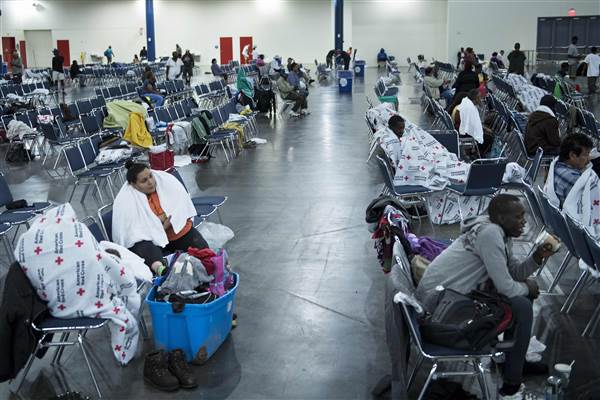
By Alex Johnson and Corky Siemazko
Nine deaths in Texas are being blamed on Hurricane Harvey and officials fear the toll could rise dramatically once the waters that have crippled the region and hobbled rescue efforts finally recede.
“We know in these kind of events that, sadly, the death toll goes up historically,” Houston Police Chief Art Acevedo said. “I’m really worried about how many bodies we’re going to find.”
The Latest on the Storm
- Harvey, now a tropical storm with maximum winds of about 45 mph, was around 100 miles east-southeast of Port O’Connor, Texas, at 5 a.m. ET Tuesday and was slowly moving back toward coastal waters.
- It is expected to remain offshore in the Gulf of Mexico before turning north, back toward southeast Texas, on Wednesday.
- Bands of heavy rain are expected to persist over the next several days, with parts of Texas and Louisiana facing record rainfall through at least Labor Day weekend, forecasters say.
- Flash flood warnings remain in effect for parts of the Houston region through Tuesday morning, and more than 260,000 customers are without power.
- The Red Cross reported 17,000 people sought refuge in shelters overnight.
- Four have been officially reported dead as a result of the storm.
- The U.S. Army Corps of Engineers has begun releasing water from both major Houston-area dams — something that has never been done before.
- The Woodforest Bridge over Greens Bayou in east Houston has collapsed.
- President Donald Trump will tour parts of Texas on Tuesday. He declared a disaster in five parishes ahead of the storm’s arrival in Louisiana.
As Acevedo spoke, forecasters warned that the massive storm — which has already done billions of dollars in damage in and around the nation’s fourth-largest city — was gearing up to hit the Texas coast again sometime later this week.
The Weather Channel warned that “localized storm-total rain amounts of up to 50 inches are not out of the question” by later this week because of the additional 10 to 20 inches expected. “This may end up being one of the worst flood disasters in U.S. history,” it added.
“This is a landmark event for Texas,” said Brock Long, administrator for the Federal Emergency Management Agency. “Texas has never seen an event like this.”
A short time later, the record for total rainfall in the continental U.S. was smashed when 49.2 inches was recorded at an intersection in the Houston suburb of Friendswood. The previous record was 48 inches, according to the National Weather Service.
In hard-hit Houston, Mayor Sylvester Turner reported more than 3,000 people have been rescued since the weekend and 150 remained in “critical” situations.
Meanwhile, 911 operators were struggling to answer the numerous desperate calls for help in a city where major highways were transformed into rivers by the unrelenting downpours and widespread flooding.
The NWS warned that “catastrophic and life-threatening flooding” remained a threat to southeastern Texas and portions of southwestern Louisiana early Tuesday.
In New Orleans, Mayor Mitch Landrieu marked the 12th anniversary of another devastating storm that wrecked his city — Hurricane Katrina — and said they have Houston’s back.
Read the entire story here.


